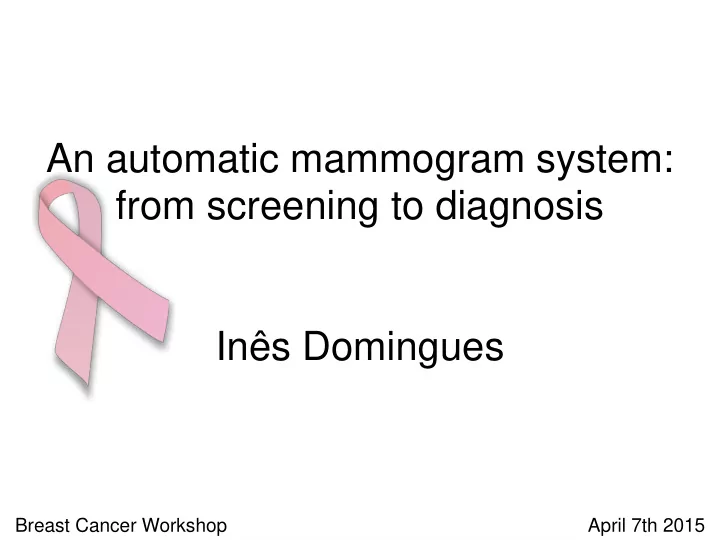

An automatic mammogram system: from screening to diagnosis Inês Domingues Breast Cancer Workshop April 7th 2015
Outline
Outline
Outline
Outline
Outline
Outline
Outline
Outline
Outline
Outline
Outline
Outline
Pectoral muscle detection Polar coordinates and the shortest path (SPPC)
Pectoral muscle detection Shortest path with endpoints learnt by SVMs (SPLE) Original image top half left half thumbnail
Pectoral muscle detection Results Differences between SPPC and SPLE • are not significant SPLE • if a robust estimation of the endpoints o can be achieved the pectoral muscle boundary can be o effectively predicted the prediction of the endpoints seems o to be the main source of errors
Outline
Screening Portuguese Breast Cancer Screening Program
Screening Breast density almost entirely fatty scattered areas heterogeneously dense of fibroglandular dense density density has been associated with a higher risk of cancer • masses and calcifications are harder to detect in dense • breasts density decreases the sensitivity of automatic systems •
Screening sensitivity and FNr better • than reported for human specialists real clinical setting • example replace one of the • radiologists during the double-reading if a disagreement • exists, the exam is sent for further investigation
Outline
Detection of suspicious regions Some types of suspicious regions
Detection of suspicious regions Calcifications for each patch of the image • compute surprise o if surprise > threshold calcification
Detection of suspicious regions Masses • SVMs with RBF kernel features • o original images o intensity value o Patch standard deviation o Patch 25 th percentile o Patch median value o Patch mean value o Patch 75 th percentile o Patch maximum intensity o Iris filtered images o Patch 25 th percentile o Patch median value o Patch maximum value ACR Sensitivity False density (%) Positives SVMs with RBF kernel • • 9 shape features area of the segmented region o I 52 3 area of the bounding box of the region o area of the region’s convex hull o eccentricity II 30 3 o length of the major axis of the ellipse that has the same o normalized 2nd-moments as the region III 26 6 length of the minor axis of the ellipse that has the same o normalized 2nd-moments as the region diameter of a circle with the same area as the region, orientation o IV 7 9 Perimeter o 1 feature that uses both shape and intensity information • distance between the centroid and the weighted centroid o overall performance: Sensitivity = 38% with 5 false positives
Outline
Characterization of suspicious regions
Characterization of suspicious regions Pearson correlation, distance correlation and Maximal Information Coefficient 7 calcification features: 9 mass features 1. Zernike moment of order 3 and repetition +3 1. Solidity 2. Zernike moment of order 4 and repetition 0 2. Compactness 3. Zernike moment of order 4 and repetition -4 3. Thinness ratio 4. Eccentricity extracted from the Spatial 4. Skeleton end points Density Function 5. Shape Index 5. Minimum of the mean intensities of the 6. Convexification calcifications 7. Extent 6. Intensity std 8. Contained lines 7. Std of the mean intensities of the calcifications 9. CC 2 = √ (Rmin / Rmax)
Outline
BI-RADS classification The scale BI-RADS Description 0 the exam is not conclusive 1 no findings 2 benign findings 3 probably benign findings 4 suspicious findings 5 high probability of malignancy 6 proved cancer
BI-RADS classification The scale BI-RADS Description 0 the exam is not conclusive 1 no findings 2 benign findings 3 probably benign findings 4 suspicious findings 5 high probability of malignancy 6 proved cancer
BI-RADS classification The scale BI-RADS Description 0 the exam is not conclusive 1 no findings 2 benign findings 3 probably benign findings 4 suspicious findings 5 high probability of malignancy 6 proved cancer
BI-RADS classification The scale BI-RADS Description 0 the exam is not conclusive 1 no findings 2 benign findings 3 probably benign findings 4 suspicious findings 5 high probability of malignancy 6 proved cancer
BI-RADS classification The scale
BI-RADS classification Motivation When more than one finding is present in the mammogram, the overall BIRADS in the medical report corresponds to the finding with the highest BI-RADS
BI-RADS classification Methods ● Max Ordinal Learning (MOL) MOL.LA o MOL.CD o Training set illustration White represents observed and gray not present features
BI-RADS classification non-MOL Model A Model B
BI-RADS classification MOL.LA initialization Model A Model B
BI-RADS classification MOL.LA subsequent iterations Model A Model B
BI-RADS classification MOL.CD initialization Model A Model B
BI-RADS classification MOL.CD subsequent iterations ● Consider Model A fixed and update Model B ~ Model A = + ● And vice-versa Model B
BI-RADS classification Experiments • Two kernels o Linear & Radial Basis Function • Model parameterization selection o two-fold cross-validation • Non-ordinal extension from binary to multi-class o one-against-one instantiated with SVMs • Ordinal methods o Frank and Hall instantiated with SVMs o Data replication instantiated with SVMs o KDLOR instantiated LDA
BI-RADS classification Results Automatic • Mass contorus segmentation does Ground truth CaPTOR not seem to Standard 15 13 negatively affect Model Baseline techniques Tri- classification results 17 16 Training Both the MOL.LA and • Non- 10 7 MOL.CD techniques ordinal MOL.LA Frank&Hall 9 7 perform better than Data the standard methods 7 8 Replication It is sufficient to o Frank&Hall 9 7 test and compare MOL.CD Data 9 7 Replication MOL.LA and MOL.CD
Outline
Putting all together Component Ground truth Automatic AOM = 0.65 CM = 0.77 Pectoral muscle detection AD = 0.06 AMED = 0.07 HD = 0.17 TPr = 0.92 TPr = 0.82 TNr = 0.18 TNr = 0.33 Screening FNr = 0.08 FNr = 0.17 FPr = 0.82 FPr = 0.67 Sensitivity = 56.4 % Sensitivity = 63.8 % Calcification detection FP = 47 FP = 49 Sensitivity = 47.6 % Sensitivity = 48.8 % Mass detection FP = 4 FP = 4 BI-RADS classification MAE = 10 % MAE = 88 %
Thank you! Questions?
Recommend
More recommend